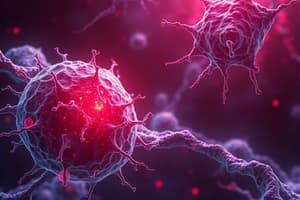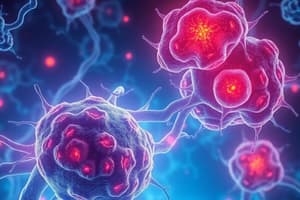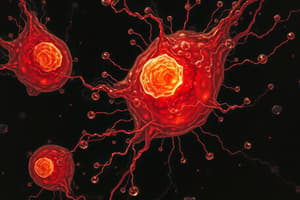Podcast
Questions and Answers
Which characteristic is least likely to be associated with benign tumors?
Which characteristic is least likely to be associated with benign tumors?
- Organized stroma
- Well-differentiated cells
- Encapsulation by connective tissue
- Invasion of surrounding tissues (correct)
What is the primary distinction between carcinoma in situ and invasive carcinoma?
What is the primary distinction between carcinoma in situ and invasive carcinoma?
- The degree of cellular differentiation
- The rate of cell proliferation
- The presence of mitotic cells
- Penetration of the basement membrane (correct)
Which cellular process is most directly associated with the 'immortality' hallmark of cancer cells?
Which cellular process is most directly associated with the 'immortality' hallmark of cancer cells?
- Increased apoptosis
- Uncontrolled cellular proliferation
- Telomere maintenance (correct)
- Contact inhibition
Which type of genetic mutation is characterized by the duplication of a region of a chromosome, resulting in multiple copies of specific genes?
Which type of genetic mutation is characterized by the duplication of a region of a chromosome, resulting in multiple copies of specific genes?
How do 'driver mutations' differ from 'passenger mutations' in cancer development?
How do 'driver mutations' differ from 'passenger mutations' in cancer development?
What is the significance of clonal expansion in the context of cancer development?
What is the significance of clonal expansion in the context of cancer development?
Which factor produced by stromal cells has the most direct impact on cancer cell proliferation within the tumor microenvironment?
Which factor produced by stromal cells has the most direct impact on cancer cell proliferation within the tumor microenvironment?
How do oncogenes typically contribute to cancer development?
How do oncogenes typically contribute to cancer development?
What cellular process is directly stimulated by autocrine signaling in cancer cells?
What cellular process is directly stimulated by autocrine signaling in cancer cells?
What is the functional consequence of tumor suppressor gene inactivation in cancer cells?
What is the functional consequence of tumor suppressor gene inactivation in cancer cells?
What is the role of the p53 protein in maintaining genomic stability?
What is the role of the p53 protein in maintaining genomic stability?
What is the most direct effect of genomic instability on cancer development?
What is the most direct effect of genomic instability on cancer development?
What process in tumor development is most directly affected by mutations in BRCA1 and BRCA2 genes?
What process in tumor development is most directly affected by mutations in BRCA1 and BRCA2 genes?
Why is angiogenesis essential for tumor growth beyond a certain size?
Why is angiogenesis essential for tumor growth beyond a certain size?
What metabolic adaptation characterizes the Warburg effect in cancer cells?
What metabolic adaptation characterizes the Warburg effect in cancer cells?
How does the loss of p53 function contribute to resisting apoptotic cell death in cancer?
How does the loss of p53 function contribute to resisting apoptotic cell death in cancer?
What is the role of tumor-associated macrophages (TAMs) in cancer progression?
What is the role of tumor-associated macrophages (TAMs) in cancer progression?
How do cancer cells evade immune surveillance?
How do cancer cells evade immune surveillance?
What is the defining characteristic of metastasis that significantly impacts cancer treatment and prognosis?
What is the defining characteristic of metastasis that significantly impacts cancer treatment and prognosis?
What distinguishes paraneoplastic syndromes from the direct effects of a tumor mass?
What distinguishes paraneoplastic syndromes from the direct effects of a tumor mass?
Which of the following best describes the changes in energy balance associated with cancer cachexia?
Which of the following best describes the changes in energy balance associated with cancer cachexia?
How can tumor markers be utilized in cancer management?
How can tumor markers be utilized in cancer management?
What is a common characteristic of malignant tumors that distinguishes them from benign tumors?
What is a common characteristic of malignant tumors that distinguishes them from benign tumors?
Which of the following processes is most directly related to the development of drug resistance in cancer cells?
Which of the following processes is most directly related to the development of drug resistance in cancer cells?
How does chronic inflammation contribute to cancer development?
How does chronic inflammation contribute to cancer development?
Flashcards
Benign Tumors
Benign Tumors
Encapsulated tumors with well-differentiated cells and organized stroma, retaining tissue structure and not spreading.
Malignant Tumors
Malignant Tumors
Tumors with rapid growth, loss of differentiation, disorganized tissue, and the ability to metastasize.
Carcinoma in situ
Carcinoma in situ
Preinvasive epithelial tumors localized and not penetrated the basement membrane.
Cancer Cell Hallmarks
Cancer Cell Hallmarks
Signup and view all the flashcards
Point Mutations
Point Mutations
Signup and view all the flashcards
Chromosome Translocation
Chromosome Translocation
Signup and view all the flashcards
Gene Amplification
Gene Amplification
Signup and view all the flashcards
Driver Mutations
Driver Mutations
Signup and view all the flashcards
Passenger Mutations
Passenger Mutations
Signup and view all the flashcards
Clonal Proliferation/Expansion
Clonal Proliferation/Expansion
Signup and view all the flashcards
Malignant Transformation
Malignant Transformation
Signup and view all the flashcards
Stroma
Stroma
Signup and view all the flashcards
Proto-oncogenes
Proto-oncogenes
Signup and view all the flashcards
Oncogenes
Oncogenes
Signup and view all the flashcards
Autocrine Stimulation
Autocrine Stimulation
Signup and view all the flashcards
Tumor Suppressor Genes
Tumor Suppressor Genes
Signup and view all the flashcards
P53
P53
Signup and view all the flashcards
Genomic Instability
Genomic Instability
Signup and view all the flashcards
Angiogenesis
Angiogenesis
Signup and view all the flashcards
Warburg Effect
Warburg Effect
Signup and view all the flashcards
Resisting Apoptotic Cell Death
Resisting Apoptotic Cell Death
Signup and view all the flashcards
Tumor-promoting Inflammation
Tumor-promoting Inflammation
Signup and view all the flashcards
Tumor-associated macrophages (TAMs)
Tumor-associated macrophages (TAMs)
Signup and view all the flashcards
Metastasis
Metastasis
Signup and view all the flashcards
Paraneoplastic Syndromes
Paraneoplastic Syndromes
Signup and view all the flashcards
Study Notes
- Benign tumors are encapsulated, contain well-differentiated cells, and have organized stroma.
- These tumors retain recognizable tissue structure and do not invade or spread.
- Mitotic cells are rare in benign tumors.
- Malignant tumors grow rapidly, lose differentiation, and disorganize normal tissue.
- They exhibit decreased cellular differentiation, variability in size and shape, darkly stained nuclei, and mitotic cells.
- Malignant tumors lack a capsule, invade vessels and surrounding structures, and can metastasize.
- Metastasis is the most important characteristic of malignant tumors.
- Carcinoma in situ is a preinvasive epithelial tumor that hasn't penetrated the basement membrane.
- It can remain stable, progress to invasive cancer, or regress.
- Uncontrolled cellular proliferation is a primary hallmark of cancer cells.
- Cancer cells display immortality.
- Point mutations are small-scale DNA changes altering nucleotide pairs.
- Chromosome translocation involves large-scale changes where chromosome pieces move.
- Gene amplification results in numerous copies of a chromosome region.
- Driver mutations propel cancer progression.
- Passenger mutations are random events that may not contribute to malignancy.
- Clonal proliferation/expansion gives cancer cells a selective advantage for rapid accumulation.
- Malignant transformation is how a normal cell becomes cancerous through progressive genetic changes, resembling Darwinian evolution.
Stroma and Oncogenes
- Stroma is the tumor microenvironment that surrounds and infiltrates the tumor.
- Stromal cells produce excessive growth factors that drive cancer cell proliferation.
- Proto-oncogenes encode components regulating normal cellular proliferation.
- Oncogenes, mutated or overexpressed proto-oncogenes, lead to unregulated cell growth.
- Gene amplification can activate oncogenes, increasing expression or creating drug resistance.
- Autocrine stimulation enables some cancers to secrete growth factors that promote their own growth.
- HER2 is upregulated in breast cancers; inhibitors can effectively treat certain breast and lung cancers.
- Translocations can activate oncogenes, causing excess production; the 8,14 translocation in Burkitt lymphomas is an example.
- The 9, 22 translocation is associated with CML.
Tumor Suppressor Genes and Genomic Instability
- Tumor suppressor genes regulate the cell cycle, inhibit proliferation, stop cell division when cells are damaged, and prevent mutations.
- Inactivation of tumor suppressor genes causes uncontrolled cancer cell proliferation.
- The retinoblastoma gene is a tumor suppressor gene mutated in retinoblastoma, breast, lung, and bone cancers.
- P53 is a tumor-suppressing gene that monitors and activates caretaker genes.
- Genomic instability is an increased tendency for genomic alterations throughout a cell's life.
- Mutations in caretaker genes elevate genomic instability, increasing cancer risk.
- Hereditary nonpolyposis colorectal cancer results from a DNA mismatch repair defect.
- Genomic instability can result from increased epigenetic silencing or modulation.
- BRCA1 & BRCA2 mutations increase the risk for breast cancer in men and women; often resulting in cancer by age 70
Angiogenesis, Metabolism, and Apoptosis
- Angiogenesis, access to blood supply, is required for cancer growth and spread.
- Without angiogenesis, tumors are limited to a millimeter in diameter.
- Inactivation of tumor suppressor genes or increased expression of oncogenes leads to increased vascularization.
- The Warburg effect is the use of glycolysis by cancer cells even with adequate oxygen.
- The Warburg effect allows more efficient production of lipids, nucleosides, and amino acids.
- This effect can be induced by the upregulation of GLUT1, regulated by oncogenes and mutant tumor suppressors.
- Cancer cells can resist apoptotic cell death, which is normally a protective mechanism.
- Dysregulation of apoptosis pathways, often due to P53 loss, occurs in most cancers.
- Caspases, like Caspase 3, are intracellular enzymes activated by apoptosis pathways, cleaving DNA and causing cell death.
Inflammation, Immune Response, and Metastasis
- Chronic inflammation from various sources is a factor in cancer development.
- Ulcerative colitis increases colon cancer risk.
- Successful tumors can manipulate the acute inflammatory response.
- Tumor-associated macrophages (TAMs) promote tumor survival and block T-cytotoxic and NK cell functions.
- TAMs produce cytokines that benefit tumor growth, invasion, and oxygen supply.
- Immune Surveillance predicts that the immune response suppresses most malignancies.
- Cancer cells develop mechanisms to evade immune surveillance.
- Defective immune responses increase the risk for lymphoid cancers.
- Immunotherapy can be active, using immunization, or passive, injecting antibodies or lymphocytes.
- Metastasis is the defining characteristic of cancer and the major cause of cancer death.
- Cancer that has not metastasized can often be cured.
- Paraneoplastic syndromes are triggered by cancer, but not by local tumor effects, and can be early symptoms.
- Cachexia is a multi-organ syndrome with decreased energy intake and increased expenditure.
- Muscle wasting and loss of white adipose tissue result from increased lipolysis and decreased lipogenesis.
- Early satiety and a feeling of fullness are common in cancer patients.
- Tumor Markers are substances produced by benign and malignant cells, found in blood, spinal fluid, or urine.
Studying That Suits You
Use AI to generate personalized quizzes and flashcards to suit your learning preferences.




